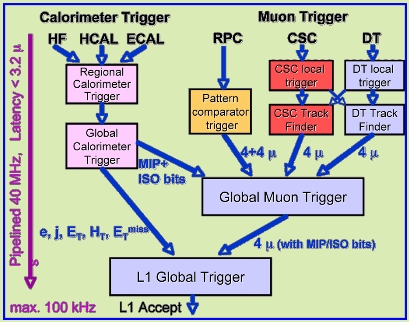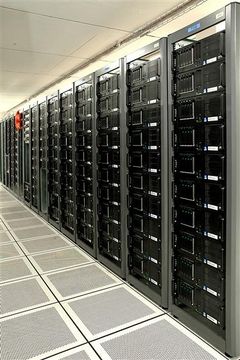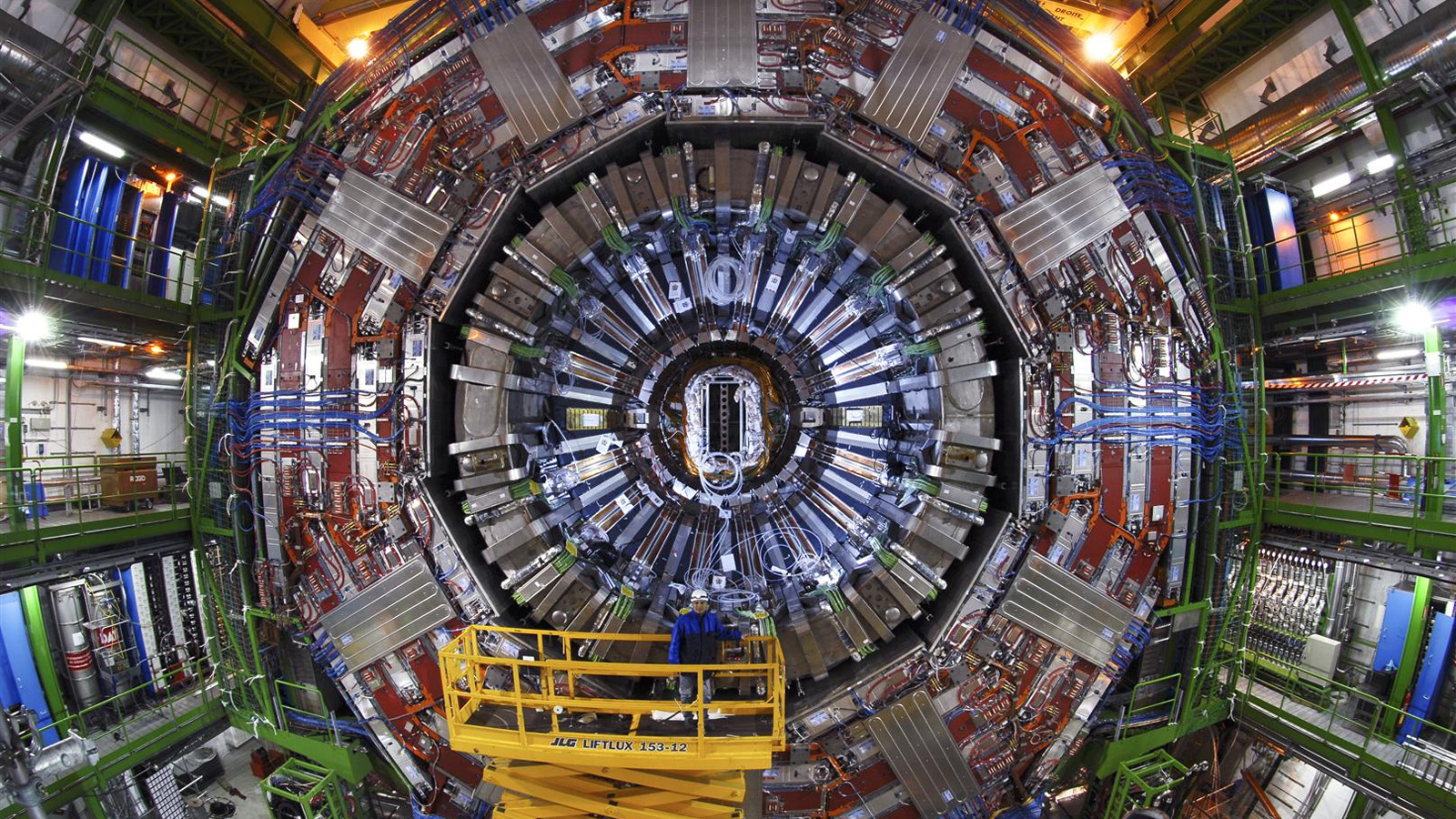Taking a closer look at LHC
In particle physics, a trigger is a system that uses simple criteria to rapidly decide which events in a particle detector to keep when only a small fraction of the total can be recorded. Trigger systems are necessary due to real-world limitations in data storage capacity and rates.Since experiments are typically searching for "interesting" events (such as decays of rare particles) that occur at a relatively low rate, trigger systems are used to identify the events that should be recorded for later analysis. Current accelerators have event rates greater than 1 MHz and trigger rates that can be below 10 Hz. The ratio of the trigger rate to the event rate is referred to as the selectivity of the trigger. For example, the Large Hadron Collider has an event rate of 1 GHz (109 Hz), and the Higgs boson is expected to be produced there at a rate of at least 0.01 Hz. Therefore the minimum selectivity required is 10−11.
Triggers usually make heavy use of a parallelized design, exploiting the symmetry of the detector: the same operation may be performed at the same time on different parts of the detector. Yet on a global scale they are essentially serial devices: in fact, they are usually divided in "levels". The idea is that each level selects the data that becomes an input for the following, which has more time available and more information to take a better decision.
Custom hardware processors make an initial decision to keep an event in a few μs using coarsely segmented data from a subset of the detectors, while holding all the high-resolution data in pipelined memories. Commodity processors make subsequent decisions using more detailed information from all of the detectors in more sophisticated algorithms that eventually approach the final reconstruction.
Each detector has its own trigger design and features. For example, in CMS the first level allows to store all data for 3.2 μs, after which no more than 100 kHz of the stored events are forwarded to the High Level Triggers. This must be done for all channels without dead time. The Level-1 (L1) system is based on custom electronics. The High Level Trigger (HLT) system, relies upon commercial processors. The L1 system uses only coarsely segmented data from calorimeter and muon detectors, while holding all the high-resolution data in pipeline memories in the front-end electronics. The HLT is provided by a subset of the on-line processor farm which, in turn, passes a fraction of these events to the remainder of the on-line farm for more complete processing.

A block diagram of the CMS L1 trigger
Let’s see now the case of LHCb detector.
The LHCb experiment is designed to exploit the large number of b-anti_b pairs produced in pp interactions at 14 TeV at the LHC, in order to make precise studies of CP asymmetries and rare decays in b_hadron systems.
The LHCb experiment operates at an average luminosity of 2×1032 cm−2·s−1, i.e. much lower than the maximum design luminosity of the LHC, which makes the radiation damage more manageable.
At a this luminosity the 10 MHz of crossings (instead of 40 MHz in CMS or ATLAS) with visible pp interaction are expected to contain a rate of about 100 kHz of b-anti_b-pairs. However, in only about 15% of the events will at least one Bmeson have all its decay products contained in the acceptance of the spectrometer. Furthermore the branching ratios of B-mesons used to study CP violation are typically less than 10−3.
So the number of interesting events per second that should be founded is:
100 kHz × 15% × 10-3 → 100·103 × 0.15 × 10-3 = 15 (15 Hz)
But remember, 10 MHz of collisions are produced, so a huge work has to be done from the trigger system.
The LHCb trigger is composed of two levels: Level-0 (L0) and High Level Trigger (HLT).
We can say that L0 is a based hardware trigger system, and HLT is a based software trigger system.
The L0 (Level-0) is implemented in custom electronics, and reduces the non-empty rate from 30 to 1 MHz at a fixed latency of 4μs. The latency is the time elapsed between a pp interaction and the arrival of the Level-0 trigger decision at the FE (The Front-End system of LHCb is defined as the processing and buffering of all detector signals until they are delivered to the Data Acquisition System-DAQ).
The purpose of Level-0 is to reduce the LHC beam crossing rate of 40 MHz, which contains about 10 MHz of crossing with visible pp-interactions, to the rate at which in principle all sub-systems could be used for deriving a trigger decision. Due to their large mass b-hadrons decay to give a large ET lepton, hadron or photon, hence Level-0 reconstructs:
- the highest ET hadron, electron and photon clusters in the LHCb Calorimeter
- the two highest pT muons in the LHCb Muon Chambers
which information is collected by the Level-0 Decision Unit to select events.
The Level-0 Decision Unit (L0DU) collects all information from Level-0 components to form the Level-0 Trigger. The L0DU is able to perform simple arithmetic to combine all signatures into one decision per crossing. This decision is passed to the Readout Supervisor which transmits its Level-0 decision to the FE.
| The HLT (High Level Trigger) have access to all data. At the 1 MHz output rate of Level-0 the remaining analogue data is digitized and all data is stored for the time needed to process the Level algorithm. This algorithm is implemented on a online trigger farm composed of up to 2000 PCs. The HLT algorithm is divided in two sequential phases called HLT1 and HLT2. HLT1 applies a progressive, partial reconstruction seeded by the L0 candidates. Different reconstruction sequences (called alleys) with different algorithms and selection cuts are applied according to the L0 candidate type. The HLT run very complex physics tests to look for specific signatures, for instance matching tracks to hits in the muon chambers, or spotting photons through their high energy but lack of charge. Overall, from every one hundred thousand events per second they select just dizaines of events and the remaining dizaines of thousands are thrown out. We are left with only the collision events that might teach us something new about physics. |
 |
For more details go to http://lhcb-elec.web.cern.ch/lhcb-elec/html/architecture.htm
The Next-Generation Triggers (NextGen) for CERN detectors
The Next-Generation Triggers project is set to remarkably increase the efficiency, sensitivity and modelling of CERN experiments
The key objective of the five-year Next-Generation Triggers (NextGen) project is to get more physics information out of the HL-LHC data.
The foundations of the NextGen project were laid in 2022 when a group of private donors, including former Google CEO Eric Schmidt, visited CERN. This first inspiring visit eventually evolved into an agreement with the Eric and Wendy Schmidt Fund for Strategic Innovation, approved by the CERN Council in October 2023, to fund a project that would pave the way for the future trigger systems at the HL-LHC and beyond: NextGen was born.
NextGen collaboratex with experts in academia and industry. The work builds on the open-science and knowledge-sharing principles embedded in CERN's institutional governance and modus operandi. The project includes a work package dedicated to education and outreach, a unique multi-disciplinary training programme for NextGen researchers and targeted events and conferences for the wider community of scientists interested in the field. The intellectual property generated as part of the NextGen Triggers project, owned by CERN, will be released and shared under open licences in compliance with the CERN Open Science Policy.
The NextGen Triggers project markx a new chapter in high-energy physics, leveraging upgraded event-selection systems and data-processing techniques to unlock a realm of discoveries.
|
AUTHORS Xabier Cid Vidal, PhD in experimental Particle Physics for Santiago University (USC). Research Fellow in experimental Particle Physics at CERN from January 2013 to Decembre 2015. He was until 2022 linked to the Department of Particle Physics of the USC as a "Juan de La Cierva", "Ramon y Cajal" fellow (Spanish Postdoctoral Senior Grants), and Associate Professor. Since 2023 is Senior Lecturer in that Department.(ORCID). Ramon Cid Manzano, until his retirement in 2020 was secondary school Physics Teacher at IES de SAR (Santiago - Spain), and part-time Lecturer (Profesor Asociado) in Faculty of Education at the University of Santiago (Spain). He has a Degree in Physics and a Degree in Chemistry, and he is PhD for Santiago University (USC) (ORCID). |
CERN CERN Experimental Physics Department CERN and the Environment |
LHC |
IMPORTANT NOTICE
For the bibliography used when writing this Section please go to the References Section
© Xabier Cid Vidal & Ramon Cid - rcid@lhc-closer.es | SANTIAGO (SPAIN) |



